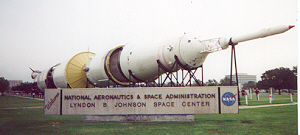

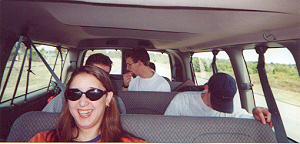 seen
here were Rhonda (in front), Carleton (head down), Jacob (behind Rhonda),
Thomas (eating breakfast!), and Tim ? Julie (in the way back). The
trip started off with a stop at the grocery store for munchies and a cheap-o
camera. (Although, some students also brought cameras. Their
pictures will be added to the website soon.)
seen
here were Rhonda (in front), Carleton (head down), Jacob (behind Rhonda),
Thomas (eating breakfast!), and Tim ? Julie (in the way back). The
trip started off with a stop at the grocery store for munchies and a cheap-o
camera. (Although, some students also brought cameras. Their
pictures will be added to the website soon.)
Although located south
of Houston, it was overcast and drizzly. 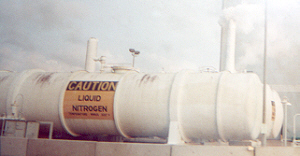 Despite the rain, it wasn't too bad a day. NASA was a cool
place. So cool, in fact that the pipe above the liquid Nitrogen tanks
were completely frosted over. :-)
Despite the rain, it wasn't too bad a day. NASA was a cool
place. So cool, in fact that the pipe above the liquid Nitrogen tanks
were completely frosted over. :-)
The intrepid crew was
led by our fearless leader, Dr. Thompson (that's him in the red shirt).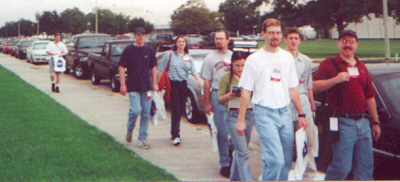 The rest of the crew is Thomas (in the lead), Tim ? Julie (in the second
row), Randy joined us in Houston (looking to his right), Carleton and Rhonda
(in the back of the pack), and Jacob (as rear-guard watching our backs).
The rest of the crew is Thomas (in the lead), Tim ? Julie (in the second
row), Randy joined us in Houston (looking to his right), Carleton and Rhonda
(in the back of the pack), and Jacob (as rear-guard watching our backs).
Our first stop was the Saturn V rocket which sits out front. The photo at the top of this page gives a top-down view, but I think this view
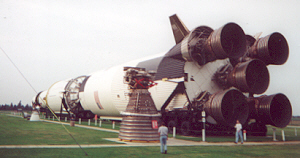
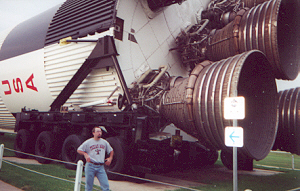 essentially everything you see is only for fuel. That's what
it takes to get off of the ground. This zoom-in with Randy also shows
some of the electronics at the base of the thruster which regulates the
fuel output/ignition.
essentially everything you see is only for fuel. That's what
it takes to get off of the ground. This zoom-in with Randy also shows
some of the electronics at the base of the thruster which regulates the
fuel output/ignition. 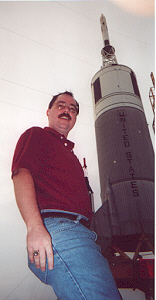 As
impressive as that sounds, it pales in comparison to Dr. Thompson,
who has the ability to spontaneously grow to an enormous size. As
he towers over the rest of humanity, he is actually the man they call when
they need to place the guidance rocket at the very tippy top of the rocket.
(He is also called in December when they place the star on top of the New
York Christmas tree, but that is a secret ceremony and we are not allowed
to show those pictures -- so for you own protection, don't tell anybody.)
As
impressive as that sounds, it pales in comparison to Dr. Thompson,
who has the ability to spontaneously grow to an enormous size. As
he towers over the rest of humanity, he is actually the man they call when
they need to place the guidance rocket at the very tippy top of the rocket.
(He is also called in December when they place the star on top of the New
York Christmas tree, but that is a secret ceremony and we are not allowed
to show those pictures -- so for you own protection, don't tell anybody.)
The annual Inspection
that NASA hosts works by open invitation to educators and industry who
visit and are treated to displays by the NASA researchers themselves. 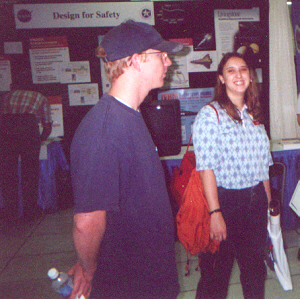 They generously lavish anybody who has a question or a look of interest
with as much information as the curious can think to ask. In this
photo, for example, Carleton observes intently a demonstration off-camera,
while Rhonda laughs as a researcher makes bunny-ears behind the camera-man.
(See how much fun you can have on the SPS adventures??!!??) The display
in the background is typical of the researchers presentations.
They generously lavish anybody who has a question or a look of interest
with as much information as the curious can think to ask. In this
photo, for example, Carleton observes intently a demonstration off-camera,
while Rhonda laughs as a researcher makes bunny-ears behind the camera-man.
(See how much fun you can have on the SPS adventures??!!??) The display
in the background is typical of the researchers presentations.
In addition to the
displays, we were also allowed to wander about on NASA's "campus."
With the rain, 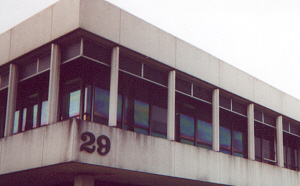 we
were able to perform some thin film experiments on the windows. (See
the multicolored layer on the windows? That is due to a thin film
of oil of varying thickness which reflects different wavelengths [colors]
of light based on the specific thickness.) You can also sit in the
experimental aircrafts as Dr. Christensen is doing here.
we
were able to perform some thin film experiments on the windows. (See
the multicolored layer on the windows? That is due to a thin film
of oil of varying thickness which reflects different wavelengths [colors]
of light based on the specific thickness.) You can also sit in the
experimental aircrafts as Dr. Christensen is doing here.
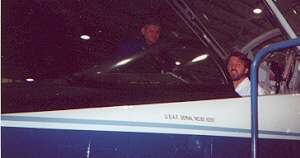
After a brief stop for lunch in the NASA cafeteria,
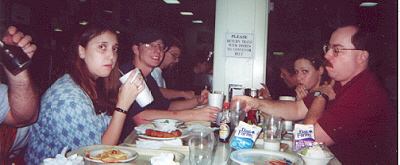
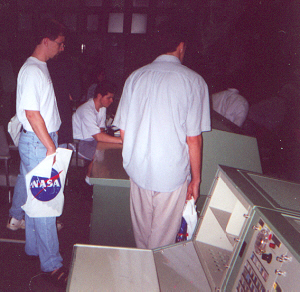 First, we joined a tour of the old "MC," where Jacob got in on the action.
With Thomas and Tim supervising, Jacob started the countdown to launch
the Saturn V rocket from its retirement perch (pictured above)! When
it didn't work, Thomas decided that a loose wire under the panel
might be the problem with the console. If Dr. Thompson's knowing
observation of Thomas and quick reactions hadn't intervened, Thomas might
have actually crawled under the desk and unwittingly repaired the panel.
First, we joined a tour of the old "MC," where Jacob got in on the action.
With Thomas and Tim supervising, Jacob started the countdown to launch
the Saturn V rocket from its retirement perch (pictured above)! When
it didn't work, Thomas decided that a loose wire under the panel
might be the problem with the console. If Dr. Thompson's knowing
observation of Thomas and quick reactions hadn't intervened, Thomas might
have actually crawled under the desk and unwittingly repaired the panel.

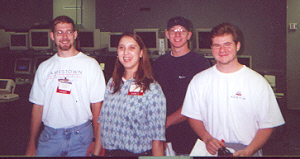 As Dr. Christensen walks into the room, Thomas, Rhonda, Carleton, and Jacob
quickly stand up and back away from the consoles, smiling innocently to
hide any appearance of inappropriate rocket launching.
As Dr. Christensen walks into the room, Thomas, Rhonda, Carleton, and Jacob
quickly stand up and back away from the consoles, smiling innocently to
hide any appearance of inappropriate rocket launching.
At the end of the day,
on our way back to the hotel, we stopped in to visit the experimental re-entry
vehicle, the X38. This will be used as an emergency lifeboat for
astronauts living on the ISS (International Space Station) to return to
Earth. Seen here are Tim and Julie showing just how small the
X38 is. 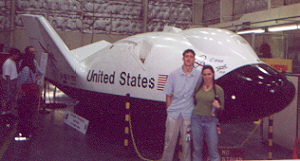 In fact,
it can be carried under the wing of a plane for testing in the upper atmosphere.
The re-entry vehicle is also designed with no means of propulsion.
When it leaves the ISS, it will fall back to Earth (not straight down,
obviously -- once it enters the atmosphere, it will glide down to the planet).
In fact,
it can be carried under the wing of a plane for testing in the upper atmosphere.
The re-entry vehicle is also designed with no means of propulsion.
When it leaves the ISS, it will fall back to Earth (not straight down,
obviously -- once it enters the atmosphere, it will glide down to the planet).